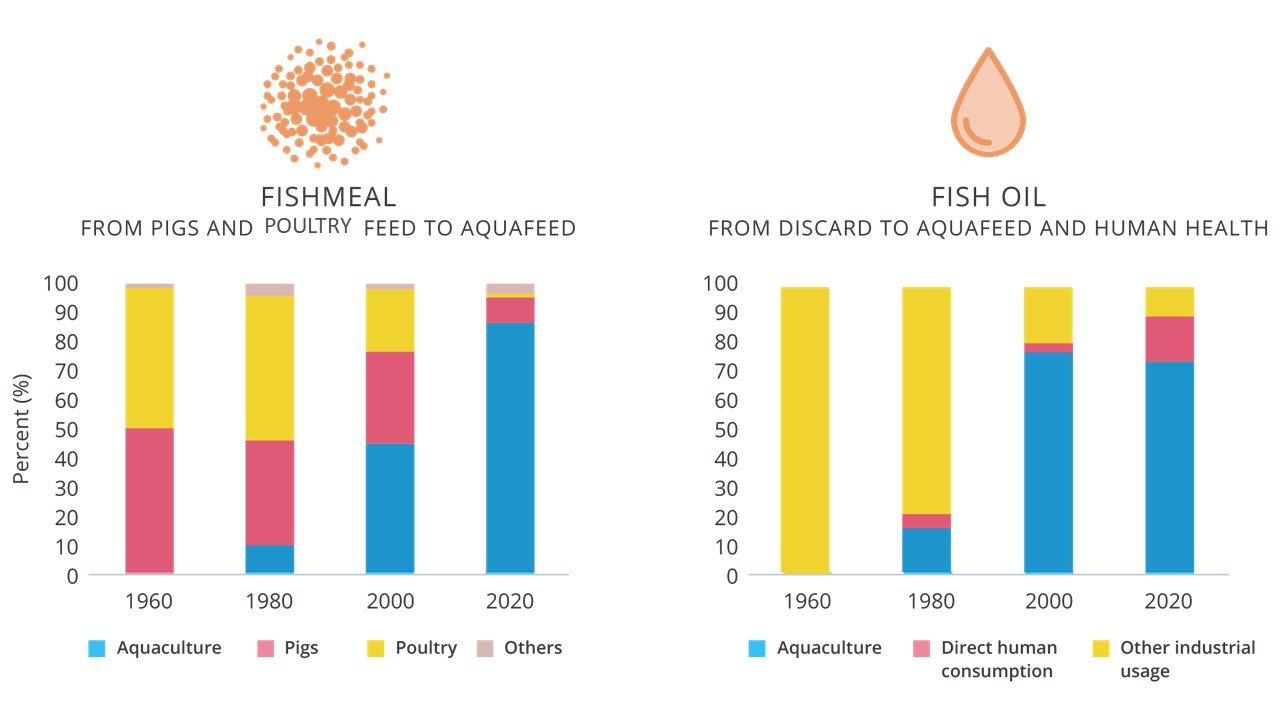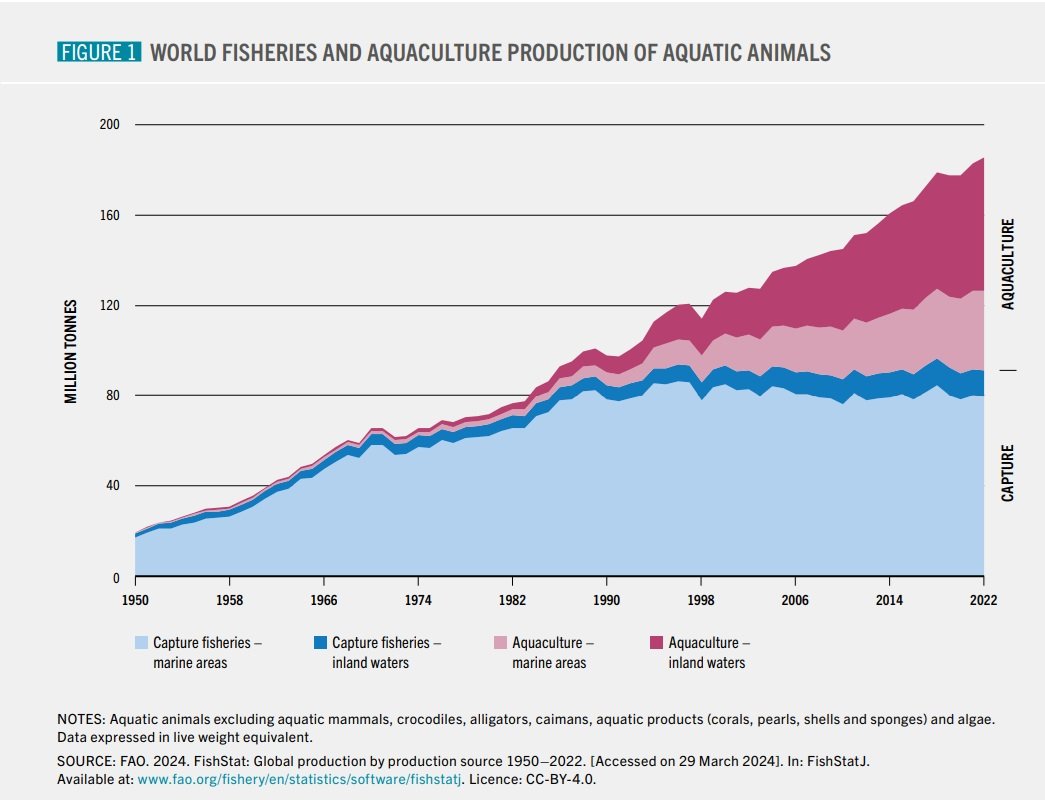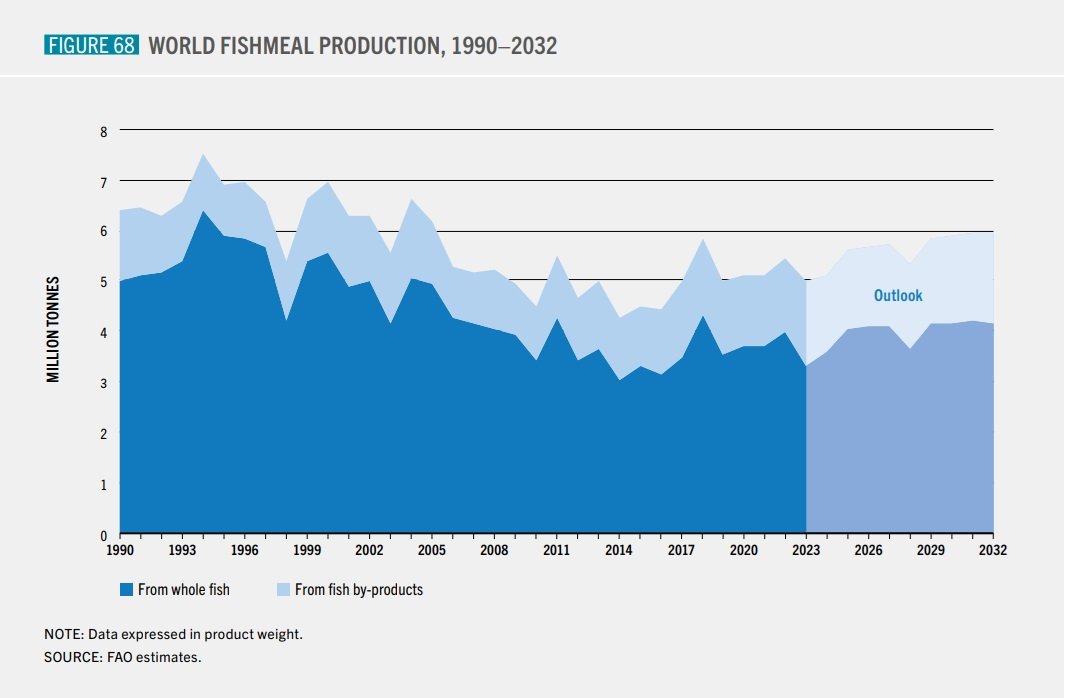Shortcuts:
The use of marine ingredients has changed markedly over the last sixty years. Click here to access our market intelligence analysis of marine ingredients use over time.

Source: IFFO, 2023
Aquaculture
A secure future relies on both nutritious and sustainable foods. Farmed fish is the most resource-efficient animal protein on the planet and is considered core to FAO’s Blue Transformation. To grow farmed fish, fishmeal and fish oil are needed at key stages of their development. "Fishmeal and fish oil are considered among the most nutritious and most digestible ingredients for farmed fish, as well as the major source of omega-3 fatty acids in animal diets. Over time, the adoption of good management practices and certification schemes has increased the volume of species fished and recognized as sourced responsibly for reduction to fishmeal, thus decreasing the volumes of unsustainable catches for those species", the Food and Aquaculture Organisation wrote in its State of the World’s Fisheries and Aquaculture, 2024. Of the total aquatic animal production (global fisheries and aquaculture production), 89% was used for human consumption in 2022. The rest went on non-food uses, mostly fishmeal and fish oil (17 million tonnes, equivalent to 83%).

(Source: FAO, SOFIA report, 2024)
Aquaculture is the most effective way to use the nutrients that small pelagic species contain. It is underpinned by a 1:5 multiplier effect: 1 kg of marine raw materials used in aquafeeds gives 5 kg of farmed fish. Small pelagic species can be used otherwise (fresh, canned, frozen), but one has to bear in mind that small pelagic species have specific features which limit the way they can be used: short life span, volatility and seasonal harvesting.

(Source: FAO - 2024 SOFIA report)
Over the past twenty years we have seen unprecedented growth in the aquaculture production sector and predictions are for this to continue. For the first time in 2022, aquaculture surpassed capture fisheries in aquatic animal production (excluding algae) with 94.4 million tonnes, representing 51% of the world total. In 2020 global aquaculture production was around 87 million tonnes per annum, using about 63 million tonnes of feed. Based on the United Nations Food and Agriculture Organisation’s (FAO) estimates for aquaculture production out to 2050 we could see aquaculture production more than double and reach yields of 140 M tonnes. However, this will also mean that feed production needs to at least double to over 100 million tonnes during this time.
It is well known that marine ingredients have played a critical role in supporting this growth by being the foundational ingredients that underpinned the development of feeds for the intensification of the industry worldwide. However, it was known back in the 1990’s that the raw material (fishery) capacity of marine ingredient production was finite and consequently a lot of work was initiated on developing various alternative ingredients for use in aquafeeds. Despite the progress in that work, marine ingredients, like fishmeal continue to be used in aquafeeds. In fact, the total volume consumed by aquaculture has increased by more than 30% in the past twenty years from 3.2 M tonnes to 4.1 M tonnes, despite the observation that the feed production for aquaculture during this same period has more than trebled (see graph below). The effective inclusion of fishmeals over this time reducing from 23% in 2000 to an average of 8% in 2020.

Global aquafeed production and fishmeal use by aquaculture from 2000 to 2020.
In recent years marine ingredients have evolved to be used more as strategic ingredients, empowering formulators to use lower cost ingredients like soybean meals and rapeseed oils to provide the bulk of the nutrients in feeds, while marine ingredients provide those critical nutrients needed for ensuring optimal animal health, vitality, and palatability of the feeds. While there is some limited prospect for increasing marine ingredient production into the future through the better use of fishery and aquaculture by-products, the potential volumes are simply never going to be enough to enable us to return to times when marine ingredients were suppliers of bulk nutrients. So, we need a strategy of complementarity whereby combinations of ingredients work together, each serving a different role.

Source: FAO, 2024 SOFIA report
It has become very clear in recent years that aquaculture is making a strategic use of marine ingredients, leveraging the high-nutrient density and palatability stimulating characteristics of those ingredients to produce those 52 million tonnes of feed. However, additional ingredients are needed to provide bulk nutrients into the future. An analysis of formulations across a range of species shows that plant proteins and oils are now providing the bulk of the nutrients in those feeds, and this is likely to remain the case for some time.
The Evolution of Sustainability metrics for marine ingredients
As the aquaculture industry has evolved over the years, so have the metrics used to measure the use of marine ingredients. By establishing relevant goals and measuring progress through clearly defined metrics, you can better demonstrate impact, effectiveness, and value. They can prove to be a powerful tool in demonstrating and communicating the use of ingredients, but they can also be misused and misunderstood so it's important to understand how they are calculated, what they cover and why. A peer reviewed research paper (2024) provides a review of the basis of each of these metrics, aspects of their origins and each of their short comings.
Each can be seen as a building block towards a better understanding of the sustainability of marine ingredients, starting with the most simple Feed Conversion Ratio (FCR), moving to the well known Fish in: Fish out ratio (FIFO) and Forage Fish Dependency ratio (FFDR); and ending with the more holistic assessment: lifecycle assessment (LCA) analyses. Each is detailed below, including calculations and the reasoning behind them. The latest IFFO figures are also included under the relevant metrics (available via click to expand). Find our more...
|
Latest articles: Shrimp now the top consumer of global marine ingredient resources (March 2023) Future feeds will focus on precision nutrition (July 2023) Latest research: Studies of interest: Feed & Nutrition Nutraceuticals (fish oil capsules for human consumption)Oily fish are the major source of omega-3 fatty acids EPA and DHA, which are now recognised worldwide as a key factor in human health. A major part of the oily fish caught is inedible. Thanks to fishmeal and fish oil production, EPA and DHA contained in these fish can be returned to the human food chain via fish oil supplements, as well as via farmed fish and even livestock. EPA and DHA found in fish oil has been the subject of numerous studies showing they confer several health benefits which are well documented (see table below). Regulatory and expert scientific bodies generally recommend 250-500mg of EPA and DHA per day for primary prevention of chronic diseases although according to a study by Mozaffarian (2008)[1] this amount is thought to be the minimum daily intake to ensure reducing the risk of fatal cardiac events. Table 1 lists a number of health benefits that are attributed to the regular consumption of EPA and DHA along with a grading depending on the level of scientific support.
Source: Adapted from ‘What is so healthy about Seafood?’ Australian Government, Fisheries Research and Development Corporation EPA and DHA are especially important for pregnant women because these essential fatty acids are key to foetal brain development and could help with the prevention and treatment of postpartum depression. It has also been shown to be beneficial for development of babies/infants - especially for the nervous system including brain and eyes.
|
Pigs and poultry feed
Fishmeal has been used in pig and poultry feed for decades due to the following benefits:
- High in protein, energy, minerals, vitamins and micronutrients, which in turn benefit humans
- Improves feed conversion efficiency (FCE) and growth rate
- Promotes livestock health – low antigenicity and antiinflammatory properties improve disease resistance
- Fishmeal’s proteins are efficiently absorbed by the animal, so reducing levels excreted
- Reduces mortality
- High in health promoting omega-3s, which in turn benefit humans.

Use in weaning and young piglets
Young piglets are extremely sensitive to the different sources of protein in their diets while their digestive system is still developing post-weaning. There can be a significant difference in the palatability and amino acid digestibility in piglets diets depending on the protein source and the processing undertaken. Anti-nutritional compounds are found in many vegetable proteins and attempts are being made to reduce these to improve piglet performance. Poor protein sources can cause greater stress to young piglets and result in poorer growth performance which can never be recovered.
| For more information explore IFFO's land animal reports. |
Petfood
- Fish oil: Omega 3 Fatty Acids (EPA and DHA)
- Fishmeal: Protein including essential AA, omega-3, nucleotides, and choline.
- High Omega 3’s have been linked to skin and coat benefits
- High Omega 3’s can contribute to brain health
- High Omega 3’s can contribute inflammatory response mediation
Typically marine ingredients are applied according to the type of finished product in which they are used, and we see extensive product labelling detailing the use of marine ingredients.
Fishmeal tends to be included in the dry kibbles as a powder, being included in with the other ingredients prior to mixing and extrusion. It is included for a range of reasons; including ingredient the product protein content, provision of essential amino acids and other nutrients to meet nutritional needs.
Fish oil on the other hand is mostly sprayed on the outside of the pellets, though in some cases it too is added to the kibble during mixing. Fish oil also has palatability benefits and like fishmeal is included to meet nutritional needs for essential fatty acids and allows producers to make certain products claims.
In terms of volumes, the petfood sector uses about 200,000 tonnes of fishmeal each year. The majority is used by North America and Europe, though both Latin America and Asia are growing consumers. In terms of fish oil volumes, only a little over 50,000 tonnes is used, with the majority of fish oil use in petfoods is in Americas and Europe.












